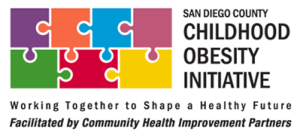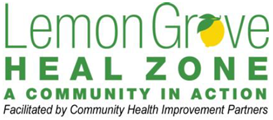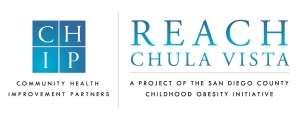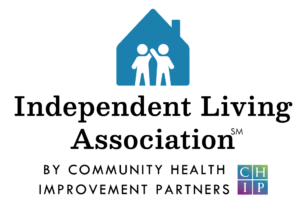Recent Accomplishments
Resident Leadership Academy
 The Resident Leadership Academy (RLA) is a 10-session training that educates community residents on how environments shape health outcomes and empowers them to advocate for healthy food access, improved public safety, and increased physical activity opportunities in their neighborhoods. Hundreds of community residents have graduated from the RLA program, resulting in community improvement projects throughout SD County. Since its founding in 2011, RLA groups have improved their communities through Farmer’s Market enhancements, neighborhood beautification, pedestrian and traffic safety improvements around elementary schools, creation of pocket farms and community gardens, enhance community volunteerism, enhance walking and biking infrastructure and encourage healthy food availability and store conversions.
The Resident Leadership Academy (RLA) is a 10-session training that educates community residents on how environments shape health outcomes and empowers them to advocate for healthy food access, improved public safety, and increased physical activity opportunities in their neighborhoods. Hundreds of community residents have graduated from the RLA program, resulting in community improvement projects throughout SD County. Since its founding in 2011, RLA groups have improved their communities through Farmer’s Market enhancements, neighborhood beautification, pedestrian and traffic safety improvements around elementary schools, creation of pocket farms and community gardens, enhance community volunteerism, enhance walking and biking infrastructure and encourage healthy food availability and store conversions.
- In July 2015, HHSA Community Action Partnership awarded a contract to CHIP to conduct two RLA Train the Trainer Workshops (Fall 2015 and Spring 2016) to community leaders and non-profit organization representatives from all parts of San Diego County, provide technical assistance to RLA groups/affiliates and maintain the bi-monthly RLA Council meetings (e.g. networking, sharing resources, promising practices, input to advocacy opportunities)
- In Fall 2015, CHIP staff provided technical assistance to independent RLA efforts underway at Sweetwater High School’s Parent Education Center (lead organization: Olivewood Gardens & Learning Center) and Helix Charter School (lead organization: HHSA East Region)
- In the Summer/Fall of 2015, the RLA Council worked in partnership with the Hospital Association of San Diego & Imperial Counties (HASDIC) to facilitate mass distribution of HASDIC’s healthcare navigation survey, which mobilized receipt of over 250 surveys countywide (2.5X the original goal). Survey responses will influence the HASDIC Community Health Needs Assessment process (2015), which is being directed by SDSU’s Institute for Public Health
- In December 2015, CHIP staff certified 14 community leaders and non-profit representatives in the RLA. The 14 certified trainers represent the following communities: Logan Heights, Southeastern San Diego (Oak Park), Ramona, Linda Vista, Chula Vista (Promise Neighborhoods), National City, and Imperial Beach
- On December 15, 2015, the RLA conducted at the Sweetwater High School Parent Center graduated 22 community residents from the program. The action plan strategies are to increase bike stations in National City, beautify Highland Avenue, and establish community gardens at Sweetwater High School and adjacent to Paradise Creek
San Diego County Childhood Obesity Initiative
 The San Diego County Childhood Obesity Initiative (COI), facilitated by Community Health Improvement Partners, has become recognized nationally as a model public-private partnership focused on obesity prevention. From 2005-2010, the collective efforts of the Initiative’s over 200 partners contributed to a 3.7% decrease in childhood obesity rates in San Diego County at a time when many California counties saw increases.
The San Diego County Childhood Obesity Initiative (COI), facilitated by Community Health Improvement Partners, has become recognized nationally as a model public-private partnership focused on obesity prevention. From 2005-2010, the collective efforts of the Initiative’s over 200 partners contributed to a 3.7% decrease in childhood obesity rates in San Diego County at a time when many California counties saw increases.
Save
Save
- Completed and implemented re-designed domain work plans, enabling improved tracking of progress toward domain objectives.
- Facilitated a strategic planning retreat resulting in key strategies in four operational infrastructure areas: (1) Demonstrated Impact/Evaluation; (2) Financial Stability; (3) Infrastructure & Partnerships; and (4) Identity and Marketing.
- Facilitated domain workgroups to share best practices, develop partnerships, and leverage resources to create healthier environments within domains and the community at large. Built partnerships with more than 200 public and private agencies and individuals.
- Released an updated and expanded San Diego County Childhood Obesity Initiative’s Call to Action: Childhood Obesity Action Plan.
The Government Domain engages government entities to incorporate health into all policies. Recent activities include:
- Supported local municipalities to adopt municipal general plans and regulations that support health.
- Hosted some of the country’s leading experts to explore the health and economic impacts of sugar-sweetened beverages (SSBs), and discuss innovative policy solutions to address the problem. These experts outlined current local, state, and federal policy initiatives to reduce access to and consumption of SSBs, and the impact of recent soda taxes implemented in Mexico and Berkeley, California. The panelists discussed the targeting by the beverage industry of demographic groups such as Latinos and African-Americans. Another speaker presented groundbreaking research looking at anticipated health impacts and positive financial return on investment of a national soda tax, and eliminating tax subsidies for advertising unhealthy food, including SSB’s, to youth. Experts included Harold Goldstein, DrPH, Kimber Stanhope, PhD, RD, Xavier Morales, PhD, MRP, and Michael Long, SD.
- Conducted a policy scan of San Diego County municipal governments, compiling a listing of policies, regulations, and codes related to safe routes to healthy places (utilizing Circulate San Diego’s data) and sugary sweetened beverages.
- With partners from American Red Cross WIC program and Scripps Health, facilitated trainings for healthcare providers and staff members to ensure consistent messaging and enhance breastfeeding environments for pregnant women and new mothers.
- Encouraged providers to adopt 5-2-1-0 messaging. Messaging has been adopted by the AAP and several major healthcare systems.
- Oversaw the work of the Nutrition and Healthcare Leadership Team (see details in CHIP Food System section.)
- Convened District Representatives and identified opportunities where they could provide technical assistance to school districts on local school wellness policies.
- Identified and assigned 16 San Diego County Childhood Obesity Initiative partners to districts across San Diego County.
- Updated the school wellness policy clearinghouse with current wellness policies from 40 San Diego County school districts including example policy language in 24 categories.
- Facilitated the San Diego County Farm to School Taskforce- comprised of more than 40 members, including more than half of San Diego County’s 42 school districts, two regional distributors, and four local farms- to increase consumption of local, healthful, seasonal foods, and improve food literacy in San Diego County school districts.
- Hosted a USDA Procurement Training for school districts on incorporating preference for local foods in competitive produce solicitations. The training was attended by over 30 people representing over 15 SD County school districts.
- Worked one-on-one with two school districts to successfully incorporate language giving preference to high quality, nutritious, local produce in the districts’ competitive produce solicitations.
- Completed an assessment of Wellness Councils in San Diego County to determine the strength of their physical activity and beverage language in their school wellness policies.
- Worked in conjunction with CHIP Food Systems department on the 2015 State of Farm to School in San Diego County Report and 2014-2015 Farm to School District Profiles for all San Diego County school districts, and two surveys important for advancing farm to institution work in San Diego County (see food systems section below).
- Conducted a Local Control Accountability Plan workshop to help participants to gain a better understanding of the LCAP and priority areas. The workshop encouraged schools to include support for healthy school environments in the LCAP to improve school climate and student outcomes and strengthen engagement of students and parents. Sixteen school districts and fourteen community organizations were represented.
- Created a Wellness Champion designation that family child care homes and centers can receive upon meeting certain criteria related to nutrition and physical activity. To date, 109 family child care homes and centers have received the designation with an additional 51 sites on a wait list.
- Provided comments on the USDA’s Food and Nutrition Services proposed meal pattern, which would better align the meal pattern with the 2010 Dietary Guidelines for Americans, by requiring more whole grains, a greater variety of fruits and vegetables, and less sugar and fat.
- Developed and piloted a GIS mapping tool that provides historical context of community advocacy and engagement efforts throughout San Diego County. The map will help residents identify advocacy their community and provide opportunities for peer-to-peer networking.
The Media Domain provides ongoing outreach efforts about policy and environmental change as they relate to childhood obesity and building healthier communities. Recent activities include:
- Disseminated over 12,500 5-2-1-0 outreach materials throughout San Diego County and thousands more via COI partners.
- Connected with and promoted partners’ efforts and communicated breaking public health news through social media, including Facebook, Twitter, and YouTube. Since their launch, the San Diego County Childhood Obesity Initiative’s social media accounts have amassed more than 1,300 followers.
- Created a success story template that can be used by all domains to capture their successful collaborative efforts. Engaged domain champions in a storytelling train-the-trainer session to further support efforts to promote San Diego County Childhood Obesity efforts.
- Surveyed 42 San Diego County school districts, representing 100% of all school meals served in the county, to gather farm to school data and provide market information to growers and distributors interested in school food services; published results in the second annual State of Farm to School in San Diego County Report.
- Hosted the 3rd annual LGL Produce Showcase on October 23rd at the Leichtag Foundation in Encinitas (see food systems section below).
CHIP Food Systems Department
 From farmers’ workshops to farm-to-school (F2S) planning to a local food tradeshow for over 200 people, 2015 was a busy year for Community Health Improvement Partners’s (CHIP’s) work to expand farm-to-institution in San Diego County (SDC).
From farmers’ workshops to farm-to-school (F2S) planning to a local food tradeshow for over 200 people, 2015 was a busy year for Community Health Improvement Partners’s (CHIP’s) work to expand farm-to-institution in San Diego County (SDC).
Save
- CHIP continued convening the SDC Farm to School Taskforce (F2ST) and the Nutrition in Healthcare Leadership Team (NHLT) in 2015, which continue to be critical initiatives advancing San Diego County’s farm-to-institution movement. The groups also serve as the “on-the-ground” networks that advance statewide initiatives like the California Farm to School Network, Healthcare Without Harm’s Healthy Food in Healthcare Program, and the California Ed-Med Collaborative.
- Through the F2ST and our strong partnership with UCSD’s Center for Community Health, CHIP provided local foods procurement expertise to over a dozen SDC school districts participating in the Harvest of the Month program.
- CHIP played a key role in expanding the Center for Ecoliteracy’s California Thursday’s program in SDC from 5 to 12 school districts. These 12 districts represent 60% of all SDC schoolchildren (over 316,000 students!), 434 schools, and collectively serve over 46 million meals annually!
- Facilitated the Nutrition in Healthcare Leadership Team (NHLT), a consortium representing 22 area hospitals working to advance healthful, sustainable food and beverage practices in healthcare. The NHLT works to engage medical institutions in adopting Healthy Beverage and Vending standards that were jointly developed in line with the COI over-arching strategy of limiting consumption of and access to sugar sweetened beverages.
- Worked with NHLT members to explore sourcing antibiotic free meats and group purchasing for hospital food service. As a result of the efforts, 2 major healthcare systems began purchasing antibiotic free poultry.
- The Let’s Go Local! Produce Showcase, was hosted on Oct. 23rd in conjunction with Food Day and brought together institutional buyers and sellers of local food together to develop face-to-face business relationships. Over 200 attendees from schools, hospitals, community orgs, higher ed., childcare, restaurants, and more met nearly 50 exhibitors including local farms, produce distributors, and educational partners. A 6-month follow-up survey on the impact of the 2014 Let’s Go Local! Produce Showcase found that over 25% of attending sellers (growers and distributors) developed new business relationships with clients met at the Showcase. Other positive impacts included an increase in knowledge of F2S opportunities, distributors now highlighting and/or labeling locally-grown products, and increasing sales of local food to existing clients.
- CHIP hosted two key trainings in 2015. One was a USDA Procurement Training where 15 SDC school districts learned how to prioritize local and regional foods in their competitive bids. Following this training, CHIP delivered 1-on-1 TA to 3 school districts to implement this language in their produce bids. The second training was a Farm-to-Institution 101 workshop in September attended by over 25 local growers interested in selling to institutions. CHIP delivered intensive TA to two school districts this year, Vista and Sweetwater, to guide them in developing 3-year F2S plans.
- Both districts hosted F2S visioning statements in July attended by dozens of district stakeholders, crafted F2S vision statements, identified challenges and commitments, and are finalizing plans for how to move F2S forward in their districts. In addition to these events, CHIP continued to play a key role in brokering business deals and relationships between dozens of institutional buyers and sellers of healthy, local, fresh food.
- This year was one of intensive research for CHIP’s Food Systems Department. The largest 2015 research effort was to reach out to over 400 local farms to learn about their comprehensive projected offerings of 75 crops in 2016, which resulted in CHIP’s 2015 Crop Availability Chart. These research efforts improve the quality and quantity of market information available to institutional buyers, local farms, distributors, and good food advocates.
- Released the 2015 State of Farm to School in San Diego County Report and 2014-2015 Farm to School District Profiles for all San Diego County school districts, which summarize each district’s farm to school activities, food service capacity, and more.
- Projected demand for local food and 2015-2016 Harvest of the Month produce items in particular amongst SD County schools. Schools will purchase a projected $12M in produce in 2015-2016, which will include roughly $5.8M of regional (California-grown) produce and $1.2M of local (SD County-grown) produce.
- CHIP also worked hard to collaborate on other valuable food systems research, taking the lead on the San Diego Food Systems Alliance (SDSFA) 2015 survey to assess barriers to new and young farmers. Over 80 responses were gathered that have been used to inform the strategy of actors ranging from SDSFA working groups, the San Diego County Farm Bureau, local funders, and emerging microfinance programs.
- CHIP’s Food Systems Department is providing contracted research and evaluation support for state and local actors including the Center for Ecoliteracy and Circulate San Diego. CHIP has continued to curate its database of over 800 San Diego County and Southern California Farms and to put it to work by strategically sharing it with leading food systems initiatives who are leveraging this data to grow the good food movement.
Lemon Grove HEAL Zone

The Lemon Grove HEAL (Healthy Eating and Active Living) Zone Initiative is a collaborative funded by Kaiser Permanente and convened by CHIP. The program empowers residents to lead healthier lives through environmental changes that are sustained by policies and enhanced by education and promotion. The Lemon Grove HEAL Zone collaborative includes organizational representatives and Lemon Grove residents representing the nine sectors most influential in creating healthier community.
Save
Save
- A total of 34 Lemon Grove residents graduated from the Resident Leadership Academy and are involved in HEAL Zone activities including the next phase of the project.
- Resident leaders advocated for a revised and strengthened Joint Use Agreement that would allow open community access to a new school Athletic Field for additional recreation space.
- Resident leaders are engaged in City-sponsored focus groups and workshops to provide community feedback and solutions to improving community safety and recreation opportunities and are providing feedback on their vision for the City via City-sponsored community workshops to update their General Plan.
- 15 Lemon Grove residents (adults and youth) attended Southern California HEAL Zone Resident Convenings in Los Angeles, Pasadena, and Ventura to share their lessons learned and maintain energy to mobilize their community efforts.
- 13 Lemon Grove youth participated in a summer Youth Summit to develop their ideas and goals for community improvement to parks, local recreation activities, and healthy retail.
- Parent in Action graduate, Rosa Carney was hired by Circulate San Diego to manage the Lemon Grove Safe Routes to School Program.
- HEAL Zone Photovoice participant, Linda Cherry became PTA president and Safe Routes to School crossing guard to ensure children are safely escorted to and from school.
- HEAL Zone Steering Committee member, Angeles Nelson, was trained as a Parent in Action training facilitator to train other parents in school-related advocacy.
- HEAL Zone Resident Leadership Academy 2013 graduate, Denise Strattman was hired as community co-facilitator for the HEAL Zone RLA 2014 cohort.
- 24 early childcare providers including both home and center-based sites became Wellness Champions adhering to a set of strict healthy eating and age-appropriate physical activity for children ages 0-5 years.
- 21 preschool gardens were built to implement Farm to Preschool curriculum at Wellness Champion sites.
Schools:
- Installed 3 high efficiency water stations to promote drinking water during the school day.
- The City of Lemon Grove developed and adopted a Health and Wellness Element to their existing General Plan ensuring policy language throughout the General Plan was aligned to include focus on healthy food and physical activity environments.
- The City of Lemon Grove passed a Community Garden Ordinance allowing residents to develop community garden space in vacant lots.
- The City of Lemon Grove passed ordinance 436 allowing the planting of edible plants and trees on multi-unity dwellings up to five units thus implementing several policies in the Health & Wellness Element including encouraging planting of edible plants and fruit.
- Completed a sidewalk at Golden Avenue and Kempf Street allowing school children, families, and residents to get to and from school and the newly opened Athletic Field safely.
- Installed physical activity equipment at Lemon Grove Park on Washington Street.
- Installed a brand new walking path at Berry Street Park providing a new place for physical activity.
REACH Chula Vista

REACH Chula Vista (Racial and Ethnic Approaches to Community Health) is a project facilitated by Community Health Improvement Partners (CHIP) in partnership with the City of Chula Vista, Sweetwater Union High School District, Chula Vista Elementary School, YMCA Childcare Resource Service, Scripps Mercy Chula Vista and UC San Diego Center for Community Health working to address two critical needs in Chula Vista; increasing access to healthy foods and increasing opportunities for physical activity.
Save
Save
Save
- REACH Chula garnered media attention on several occasions by both print and TV media such as Ella Magazine, KPBS and Azteca America.
- All 5210 materials were rebranded to include the REACH Chula Vista logo and new “0” messaging.
- Completed planning and media buy for a 2016 Spanish language 5210 campaign on radio, billboard and TV.
- Formed Media Advisory Group (MAG) comprised of the communications/external affairs staff from partner organizations and continued to meet once per month.
- In September, the Planning Commission approved proposed changes to the City’s General Plan incorporating healthy community concept and language. The final approval was given by the City Council i October.
- Completed a Community Needs Assessment with the help of City Place Planning to support the revision of the City’s Recreation Master Plan.
- Completed a Health Impact Assessment on the Healthy Chula Vista Action Plan with the help of Human Impact Partners. Results from various community engagement meetings, stakeholder groups and evidence-based research was taken into consideration prior to creating the final Healthy Chula Vista Action Plan and presenting it to Council.
- Established new and meaningful relationships with several organizations such as Feeding America, South Bay Community Services and local based businesses such as Sprouts to better address food insecurity issues.
- Established on campus pop-up farmer’s markets at middle schools in collaboration with Food 4 Thought, bringing fresh local produce to the students.
- Developed standards and expectations for Culinary Skills Training and contracted with Kitchens for Good to deliver trainings.
- Established a Wellness Champion Program that focuses on implementation of policies and environmental changes in childcare settings that promote healthy eating and active living. The program requires child care providers receive training, engage in coaching with a CRS Health Educator, follow best-practices concerning for obesity prevention and establish a written wellness policy in order to receive the Wellness Champion Designation.
- Eight sites located in the REACH Chula Vista target region where designated as Wellness Champions.
- Advocated for the inclusion of toddler and infant nutrition and development in Child Care Initiative Project (CCIP) training topics. YMCA CRS developed a curriculum addressing this focus area and will now be incorporated into the learning modules and will become a required core course for all CCIP graduates.
- Developed curriculum in collaboration with UC San Diego’s School of Medicine-Lactation Supportive Environments to assist childcare centers in establishing breastfeeding friendly policies and infant feeding plans.
- Designation and creation of lactation room at Chula Vista Medical Plaza (CVMP) andinitiated breast pump availability at clinic to assist patients.
- Increased staff knowledge at CVMP, as a result of CVMP RN going through Certified Lactation Educator (CLE) course and through extensive training with neonatologist and hospital IBCLC. All staff trained in providing a breastfeeding friendly environment in all clinic areas.
Independent Living Association

The Independent Living Association (ILA) is a collaborative community-wide effort focused on supporting independent living operators, tenants and the community by promoting high quality independent livings. This ground breaking project, which began in July 2012 in San Diego County, is the first of its kind to organize and promote Independent Livings. Since 2012, the ILA has expanded to Alameda County (2017) and Fresno County (2018).
-
The ILA in San Diego County has 102 member homes representing 964 beds.
Numbers are current as of June 1, 2020
-
The ILA in Alameda County has 20 member homes representing 134 beds.
Numbers are current as of June 1, 2020
- The ILA in Fresno County has 5 member homes representing 34 beds.
Numbers are current as of June 1, 2020
Recovery Residence Association

Recovery residences are privately-owned homes or complexes that provide housing for adults with a substance use disorder (SUD) or co-occurring disorder. They serve individuals that are currently receiving outpatient SUD services or are enrolled in recovery services.
Save
Save
Save
Save
-
The RRA in San Diego County has 41 member homes representing 328 beds.
Numbers are current as of June 1, 2020
Suicide Prevention Council

The San Diego County Suicide Prevention Council (SPC) is a collaborative community-wide effort focused on realizing a vision of zero suicides in San Diego County. Our mission is to prevent suicide and its devastating consequences in San Diego County. Since 2010, with continued support from the County of San Diego Behavioral Health Services, CHIP provides direct oversight and guidance toward the implementation of the Suicide Prevention Action Plan. CHIP in partnership with 125 active community partners facilitates monthly SPC meetings to advance collaborative action goals of the Council.
Save
Save
Save
Save
Save
- SPC has trained almost 10,000 people in San Diego (since 2011) in Question, Persuade Refer (QPR). A total of 1,965 San Diegans were trained in QPR in 2015.
- The SPC, in partnership with the VA San Diego Healthcare System and 211 San Diego, trained 41 new QPR trainers in the County in February 2015.
- SPC conducted three Applied Suicide Intervention Skills Trainings (ASIST) in partnership with SPC community partners targeting Native American communities, Social Work students at the University of Southern California San Diego Academic Center, and Suicide Prevention Council members. A total of 71 individuals completed the 2-day workshop. ASIST is suicide first aid in which participation is highly interactive, practical, and practice-oriented and empowers one on how to prevent the immediate risk of suicide.
- SPC held a 2-day media forum and PIO workshop event to share safe reporting for strategies to reduce suicides and promote mental health recommendations to media and public information officer audiences that have the ability to save lives by operationalizing the recommendations (April 2015). A total of 39 individuals attending the Media Refresher event and 25 individuals attended the PIO Workshop training.
- SPC held its 1st SPC Medical Provider Roundtable with 200 people in attendance to discuss current suicide risk reduction systems in place, and the feasibility of implementing the Columbia – Suicide Severity Rating Scale tool in San Diego County across diverse settings. (February 2015)
- SPC held its 2nd SPC Medical Provider Roundtable with 71 people in attendance to discuss the “Why and How of Implementing the Columbia – Suicide Severity Rating Scale tool” in San Diego County across diverse settings. Evaluation findings indicate that this continuing education workshop on suicide risk with the C-SSRS and the Safety Plan Intervention was effective in making positive changes in the attitudes towards suicide prevention and increasing the possibility that more providers will conduct suicide risk assessment in their work settings compared to their current practices. (July 2015)
- SPC conducted their 4th Annual SPC Faith Provider Breakfast event with 97 people in attendance to learn from other congregations on their promising practices in reducing suicides and promoting mental health and wellness in their respective communities. The theme of this year’s breakfast focused on empowering congregations and sharing personal testimonies. 16 different congregations were represented at this year’s breakfast. Since 2012, the number of attendees has doubled in size. (May 2015)
- Partnered with the Behavioral Health Advisory Board’s Suicide Prevention Workgroup for a 6-month period in 2015, which led to the Workgroup’s prioritization of 12 recommendations to strengthen suicide prevention efforts in San Diego County. Two of the top recommendations included (1) an augmentation of monetary resources dedicated to facilitation/convening of the San Diego County Suicide Prevention Council and (2) implementation and adoption of the Columbia – Suicide Severity Rating Scale across County behavioral health systems.
Health Literacy San Diego

Health Literacy San Diego (HLSD) is a joint effort of Community Health Improvement Partners and the San Diego Council on Literacy with the mission to improve healthcare communication by addressing literacy abilities, language barriers and cultural differences.
Save
Save
Save
Save
Save
Save
- In 2015, Health Literacy San Diego (HLSD), produced a new report titled, Improving Health Communications: A Collaborative Plan to Address Health Literacy in San Diego County. The new report updates the 2007 health literacy report, When Words Get in the Way: A Collaborative Plan to Address Health Literacy in San Diego County. The report was funded by the Alliance Healthcare Foundation, with additional support from Molina Healthcare. It highlights the impact of low health literacy in terms of overall health and wellness, and higher mortality; provides a review of recent major federal policy initiatives for improving health literacy; and innovations and promising practices being used by providers and health care systems to address health literacy.
- HLSD conducted two health literacy trainings to healthcare professionals on how to better communicate with patients. The trainings were provided at the Prenatal Care Network meeting and at the Naval Medical Center to physicians and nurses. There were a total of 80 healthcare professionals in attendance. The training provides an overview of health literacy and its impact on patient outcomes, methods to recognize patients with low health literacy and provides evidence-based strategies to better communicate with patients with low health literacy.